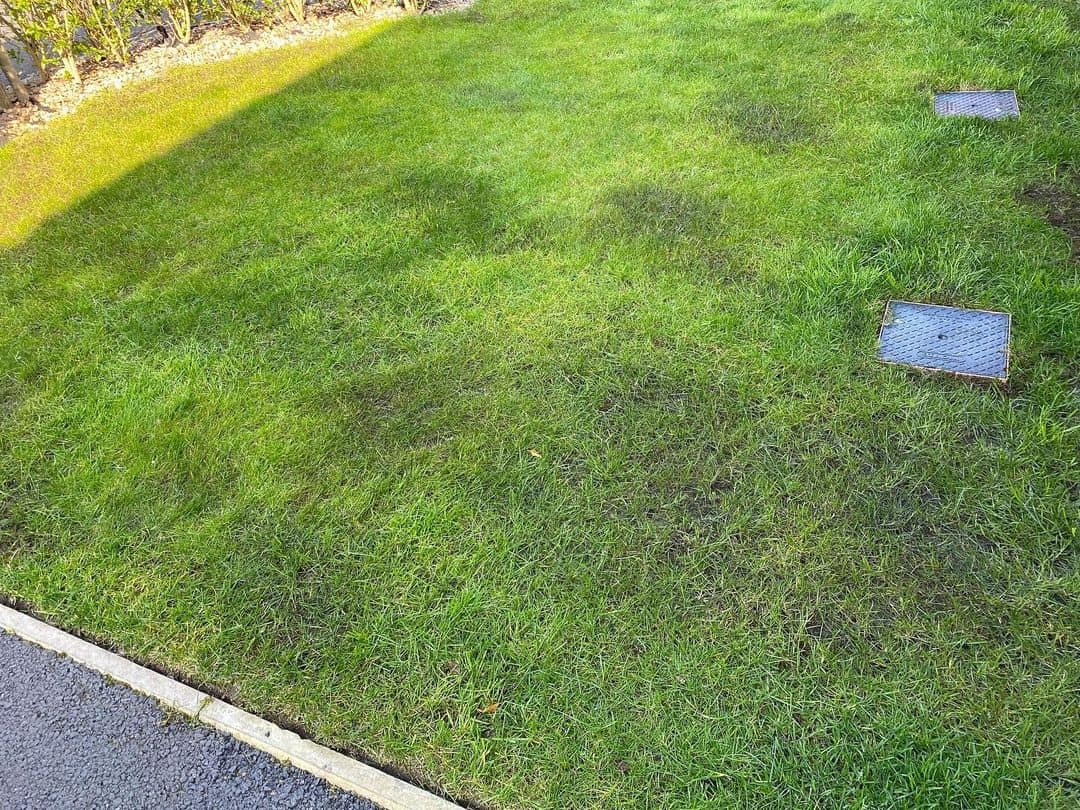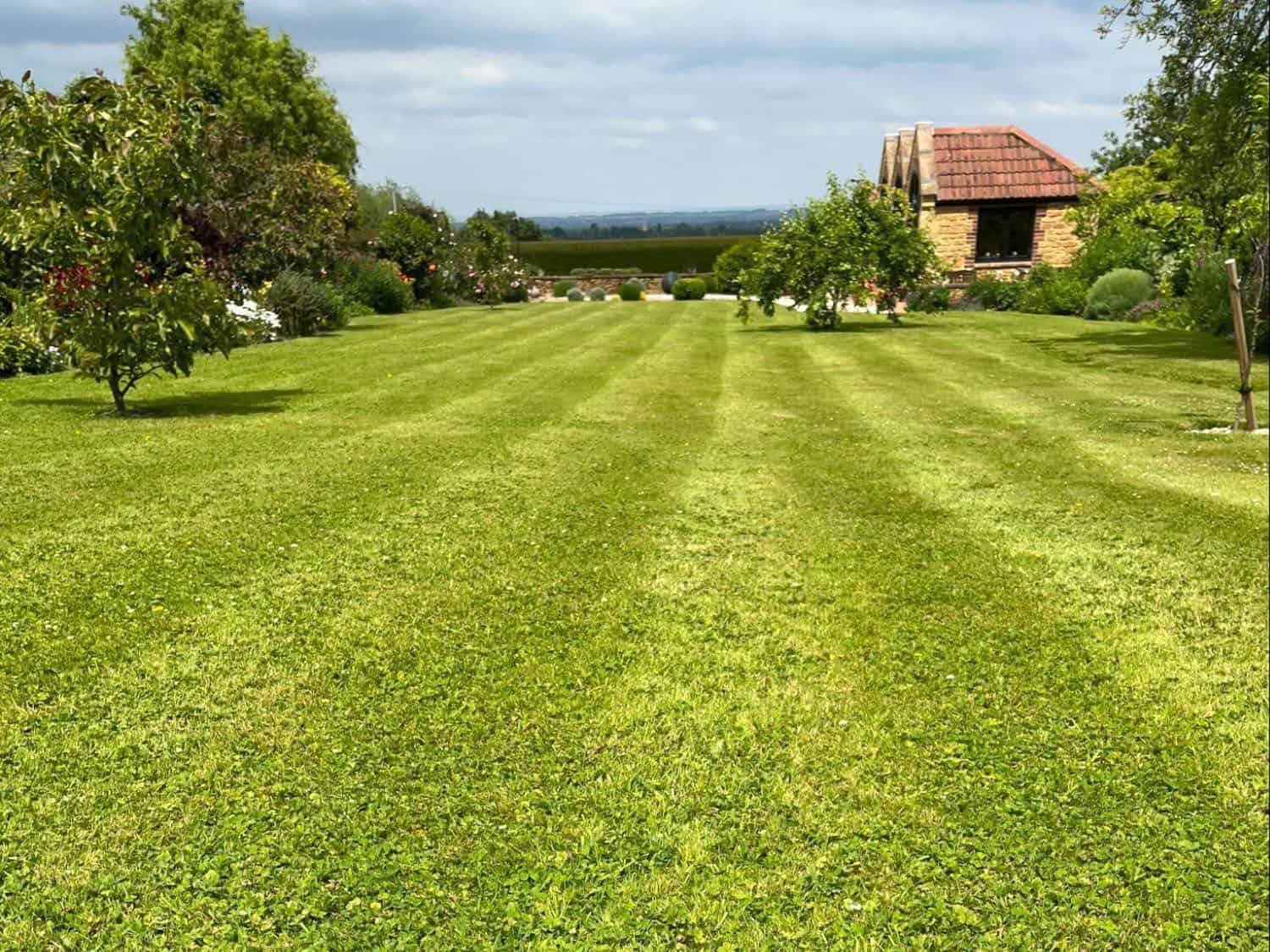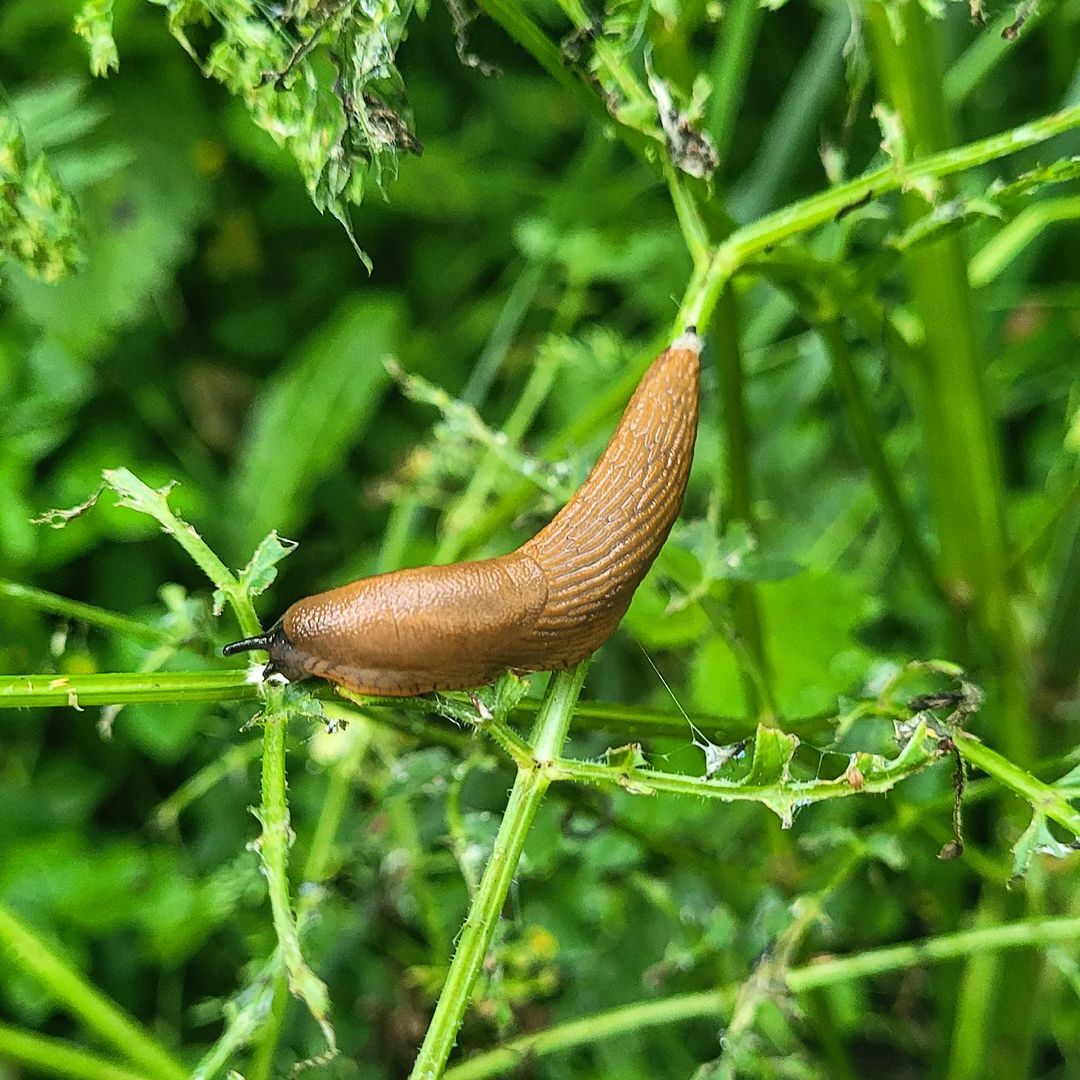Is the grass greener on the other side? That’s probably because your neighbour is applying iron sulphate to their lawn.
Iron sulphate helps to greenify the grass without increasing growth, water needs and other maintenance tasks. It also eliminates moss, deters pests and gives your lawn a super-boost of nutrients. In other words, it’s a great lawn health booster.
Iron sulphate may be something your lawn needs, but it’s possible to add too much of it. Accidental spills or over-application might burn the grass blades and turn your lawn a sickly yellow. However, there are ways to fix iron sulphate overdose. Add lime, bicarbonates or zinc to even out iron levels. Also, improve your lawn’s drainage and you’re good to go.
Read on to find out if your lawn has an iron sulphate problem and how you can fix it.

Areas of iron damage on a lawn. Image credit: @lawncarewithmike
What does iron do for grass?
Iron sulphate has many uses around the lawn. It can quickly green up your lawn, harden cool weather turf by boosting soil nutrients, deter pests and control moss.
Let’s take a closer look at each of the benefits of iron sulphate on your lawn:
Turns grass green
Looking to green up your lawn? Iron sulphate can be the answer. It boosts photosynthesis and turns sickly yellow grass to pristine green.
What’s more, liberal spraying of iron sulphate will show results within a week after application. Plus, your lawn grass will not grow at an accelerated rate or require any additional maintenance.

A lush green lawn after successful iron application. Image credit: @jayrock_lawncare_gardening
Hardens the turf
Iron sulphate also boosts soil nutrients. This will strengthen the grass blades and encourage healthy grass roots. In other words, your lawn won’t just look great, it will also brave the winter frosts more easily.
What’s more, stronger grass is more resistant to autumn lawn diseases like red thread, snow mould and brown patches. It can be a good idea to spray some iron sulphate on your lawn before autumn comes your way.
Read more: Autumn lawn care: 9 grass treatments in the correct order
Deters pests
Are ants, ticks, grubs and leatherjackets making a mess of your lawn? Iron sulphate can help deter them by increasing the acidity of the soil.
Acidic soil will make your lawn less appealing to pests and they will slowly begin to vanish. Not to mention, lawn grass loves a bit of acidic soil and will turn soft and fine so it’s a win-win.
Kills moss
If moss has invaded your lawn, you can count on iron sulphate to blacken and kill it. After application, rake the moss out to restore your lawn to its former glory. Since iron sulphate is an organic chemical compound, it’s also more eco-friendly than many synthetic moss killers.

The effect of iron sulphate on moss. Image credit: @vines_gardenservices
Bear in mind that the effects of iron sulphate application may last only a season or so. For permanent results, you’ll have to take additional steps to eradicate moss.
Read more: How to get rid of moss in the lawn
Can too much iron sulphate hurt your lawn?
If your lawn is looking rather discoloured, the soil pH is too low, or the tips of your grass blades are drying out suddenly, these may be signs of iron toxicity in your lawn.
Too much iron sulphate can hurt your lawn. And if iron excess persists for too long, your lawn may also begin to die. So, watch out for these signs of too much iron sulphate on lawn:
Lawn discolouration
One of the first signs of too much iron in your lawn is discolouration. Your grass will begin to turn dark green or even black or purple. You may even notice iron toxicity spreading to hard surfaces like the pavement or driveway.
Don’t worry. In most cases, lawn discolouration due to excess iron is temporary. Your lawn will begin to resume its normal appearance in 3 to 4 days.

A lawn after an iron overdose. Image credit: @lawncarewithmike
Low soil pH
Most turf grasses grow best in soils with a pH between 6 and 7. Too much iron application can drop your lawn pH almost immediately.
This will turn your lawn grass brown and a bit sludgy in appearance. Plus, it will interrupt the ability of the grass to take in other important micronutrients, like nitrogen, potassium and phosphorus.
Burnt grass blades
If your grass starts turning yellow and gradually appears burned, scorched and brittle, chances are there’s too much iron sulphate on the lawn.
This causes the most damage in hot and rainy weather. The only way to revive your burnt grass is to reduce the iron content in the soil.
How much iron sulphate per litre?
We recommend applying 1 gram of iron sulphate per litre of water per square metre. This will offer the perfect greening effect to your lawn without any side effects like burnt or discoloured grass.
If you are using iron sulphate for turf hardening, you can use 2 to 3 grams per litre of water per square metre. This is ideal for sports pitches and golf courses.
The easiest way to add iron sulphate to your lawn is by dissolving the desired amount in water. You can then apply the solution using a pump sprayer or a watering can.

Apply iron sulphate with a sprayer. Image credit: @greenlawns.info
How often can I use iron sulphate on my lawn?
When applied in moderation, iron sulphate can work wonders for your lawn. It will turn your grass lush green, boost soil nutrients, deter lawn pests, and kill stubborn mosses.
You can use iron sulphate four times a year on your lawn. That is, once every season. Make sure you use it in moderation for the best results.
Below are some pointers to keep in mind while applying iron sulphate on your lawn:
- Avoid applying iron sulphate on grass less than 3 months old
- Don’t use it in the same week as a weed killer
- Avoid spraying it on the pavement, patio, or paths, as it can damage or stain hard surfaces
- Combine it with other fertilisers to get complementary results
- Apply it on a windless day or the mix will spread into other areas of your garden
- Water the lawn a few hours before application for better iron absorption
- Avoid application on a day with heavy showers as the excess water will wash away the iron sulphate
How to fix issues with too much iron sulphate in lawns
From applying lime, bicarbonates and zinc to improving your lawn’s overall drainage, here are some surefire ways to fix iron sulphate problems in your lawn:
Apply lime to the soil
Applying lime to your lawn can help solve the acidity problem. It will increase the soil pH and even out the iron levels. What’s more, lime will also add other nutrients like calcium and magnesium to the soil.
Keep in mind that lime comes in different varieties so pick the one that suits your lawn and needs. At the same time, don’t over-apply lime as it can kill the grass.

Adding lime to the soil will help to neutralise the acidic iron. Image credit: @bloomsandblessing
Wash away excess iron sulphate
You can also add large amounts of water to your grass to wash away excessive iron sulphate. This will reduce iron levels in the soil and restore your lawn’s health.
Once the soil dries up, apply a lawn fertiliser to ensure that the soil gets the right balance of micronutrients. Otherwise, there may be a nutrient deficiency, hampering the growth of the grass.
Add bicarbonates to the soil
Bicarbonates can reduce the effects of iron on your lawn. They are less ideal than lime but can save your lawn in case of an iron overdose or accidental spill.
When applying bicarbonates, make sure to follow the directions on the packaging. Also, avoid using household baking soda as it may further damage your lawn.
Apply zinc and molybdenum
Once you have applied lime to your lawn, you can also add some micronutrients like zinc or molybdenum. Make sure to add only the recommended dosage. Too much of anything is bad for your lawn.
Zinc and molybdenum will help the grass absorb a balanced ratio of iron. They will also combat the micronutrient imbalances in your lawn.
Improve lawn drainage
Finally, check that your lawn has proper drainage. Stagnant and pooled water will only increase the concentration of iron and worsen the damage to your lawn.
You can work on clayey and compacted soil for better drainage. Or create a berm to redirect the water flow. Doing so will also help improve the health of your lawn.
The wrap-up
Apply iron sulphate cautiously and it can work wonders for your lawn. It will give your lawn a rich green hue, keep pests and mosses at bay and boost your lawn’s health.
But go overboard with iron sulphate, and you risk burning the grass while increasing soil acidity. Lawns simply don’t like too much iron sulphate.
There are a few ways to combat iron toxicity. This includes applying lime, bicarbonates and zinc to your lawn. In addition, you can wash away excess iron and improve your lawn’s drainage.
In the end, rather than having to worry about dealing with high iron levels in your lawn, apply iron sulphate with care. Your lawn will be all the greener for it.

Save this pin for later






